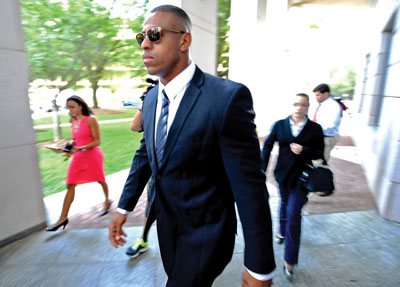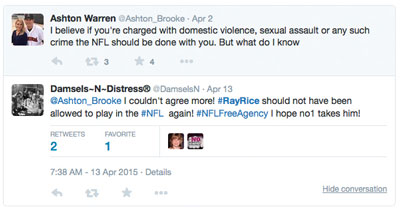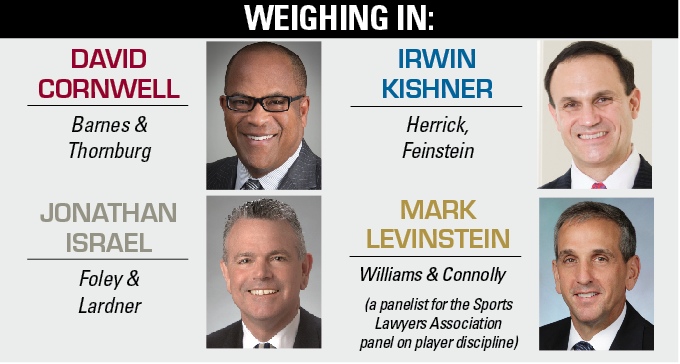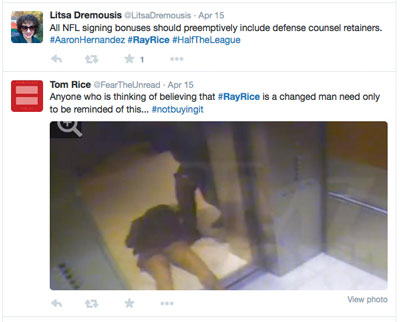When SportsBusiness Journal was planning this section, we asked many sports lawyers to identify the legal issues that were on their radar. The topic of player discipline was easily the issue cited most often. Case in point, at this week’s Sports Lawyers Association annual conference in Baltimore, one panel will focus solely on the issue of player discipline. We asked four lawyers to tell us more about the legal issues in play with player discipline, the role of social media in pushing for swifter action, and how they would design an ideal system for player discipline. Here are highlights of the responses they submitted.
What do you see with recent high-profile cases of player discipline in the major sports leagues that has you watching this area closely?
DAVID CORNWELL: With the breathless, breaking news aspect of the media’s coverage that attends these matters, we invariably get inaccurate and incomplete stories. This media coverage shapes the thinking of the public and league sponsors — even if it is inaccurate and/or incomplete. Since the leagues are particularly concerned about the public relations impact of these events, we have the circular effect of incomplete and inaccurate media coverage shaping ill-informed public opinion and then the leagues act and respond to that ill-informed public opinion to protect the leagues’ interests. Sensational and salacious media reports that are “sourced” have become a suitable substitute for accurate news stories for editors and producers across the media landscape. Inaccurate coverage, big headlines and “breaking news” crawls become a significant factor in how leagues respond. … As a result, often the least-informed among us can have the greatest impact on how the leagues ultimately handle these matters.
JONATHAN ISRAEL: Off-the-field player misconduct is nothing new; it now just seems more visible with the constantly open lens and microphone of these times, and it’s potentially more relevant to the business today because leagues and teams are selling more than just games and competition (e.g., behind-the-scenes looks at players and operations — see HBO’s “Hard Knocks”). Twenty years ago, the [Ray] Rice and [Greg] Hardy stories might last a 24-hour news cycle or even go unnoticed; today, they are the subject of ceaseless coverage in every realm of media.
… Since the 1990s and until recently, the NFL’s labor-management relations have been relatively easy, with the CBA rolling over from term to term with little volatility. Historically, the NFL commissioner has retained significant disciplinary authority, and disciplinary decisions relating to off-the-field conduct are reviewable by the commissioner (or his office), not an independent third-party. Things now seem to be changing with the stops and starts of the commissioner’s new conduct policies and the legal challenges brought by the players union in the Rice, [Adrian] Peterson and … Hardy cases. Indeed, with [arbitrator and former federal judge] Barbara Jones hearing and deciding the Rice appeal, it was the first time an individual outside the commissioner’s office determined an appeal of player discipline for off-the-field conduct. Historically, given the commissioner’s expansive authority, the NFL may have been less attendant to due process in the context of a collective-bargaining agreement which didn’t really require it. And this may have created an opening when Rice and others like Adrian Peterson began to press process and other fairness arguments after the commissioner tried to set new standards and penalties there in the face of immense public pressure.
 |
Greg Hardy is among the players the NFL has disciplined over domestic violence issues, but the players union is challenging the extent of the punishment.
Photo by: Getty Images |
IRWIN KISHNER: We’re seeing teams and leagues recognize that a major player discipline issue can have repercussions on the entire sport, which can drag down attendance and erode fan support. … I’m also cognizant of what I’m not seeing. We now have uniformity among the league drug policies, but lately we’re seeing fewer players getting caught using performance-enhancing drugs, which could be a false positive. I think the leagues haven’t gone far enough in this area, the drugs are becoming more sophisticated, and players have somewhat wised up to the new testing procedures. So the PED issue is definitely one that needs further consideration.
MARK LEVINSTEIN: The issue is now not limited to player discipline. This is an issue that has been or will have to be faced at some time by every league, team, players association, university and sports organization. Athletes, coaches, officials, front-office personnel and team owners are going to do things from time to time that will put them in a bad light and today the media/fans, when they learn of such conduct, will express the view that the offending individual should be punished and may try to pressure the employer to impose punishment — that is the nature of our culture today.
The view that a sports employer (or university) has an obligation to punish for conduct not directly connected to the workplace or playing of the sport, and general public awareness of everything people in the sports industry do … is becoming more of an issue. The costs associated with these issues can be very significant (investigations, hearings, arbitral or judicial proceedings, public relations-related expenses, time and resources of people in the organization, taking fan and media focus off of the entertainment product). Planning, developing policies and procedures, making general assessments outside the context of specific cases, reaching contractual agreements with employees, can yield benefits — lower costs, less coverage and more positive coverage.
What key legal issues do teams and leagues face as they administer player discipline?
CORNWELL: Due process concerns will continue to plague the process. Whether it is compromising principles of innocent until proven guilty or limiting fundamental rights pending the ultimate resolution of a matter, these due process concerns will result in contractual challenges by players. Additional, related claims arising from premature or unwarranted action that negatively impacts a player’s commercial and other significant interests are likely to follow.
ISRAEL: The CBAs and rules concerning industrial relations effectively limit the discretion leagues and teams have to take whatever action they may deem appropriate. Due process is generally the governing principle, which means the player is entitled to some standard of fairness in process (e.g., an opportunity to be heard) and fairness in any penalty imposed (i.e., notice of the penalty that might be imposed for the specific conduct in question; and no double jeopardy, i.e., being punished twice by the team and/or league for the same conduct). … To render discipline, the leagues and teams must construct their cases around evidence that supports any discipline and give the player an opportunity to participate in the investigation and challenge any decision. … Any failure to adhere to established process or precedent are potential stumbling blocks that can derail a case and make any decision susceptible to a successful challenge by the player. A successful challenge which results in a reduction or reversal of any penalty or decision can have broader consequences in the context of the collectively bargained relationship — new standards may be established for the next case that comes along and can alter bargaining positions in future negotiations.
Do you think social media has influenced decision-making on player discipline, perhaps by applying more pressure for quick action?
CORNWELL: Yes. Twitter abhors context and media outlets’ desire to be first has overwhelmed the journalist’s obligation to be right. Too many in the media have abdicated journalistic obligations to break some news or be viewed as an insider. I talk to members of the media all of the time who publish something even though they knowingly have not read or reviewed all of the information available to them because of the social media’s pressure to be first or fast. Consequently, because of the reach of various media platforms, ill-informed opinion masquerades as well-informed news. As noted previously, this creates a vicious cycle that results in the leagues taking action based on incomplete or inaccurate information.
 |
Social media has increased the pressure on teams and leagues to take swift action on player discipline.
|
ISRAEL: Leagues and teams may gauge how sponsors and season-ticket holders will respond to a particular case or the extent of any discipline imposed. Players and unions may weigh similar concerns in deciding whether to accept or challenge any discipline and might focus on whether there is some economic gain with sponsors and fans in accepting the penalty and moving quickly to personal accountability and public rehabilitation. It may well be that, in this age of instantaneous information and intense scrutiny, there will be a heightened sensitivity to the business impact here on both sides of the relationship. With this new order, you also may see leagues taking a much more proactive approach to investigating and resolving disciplinary issues, even in the context of a criminal investigation.
They may be more inclined to abandon the long-standing “wait and see” approach to any ongoing criminal investigation, and there is nothing that prohibits leagues or teams from doing what they need to do on the employment front, irrespective of criminal proceedings. It may be in their best interest to act quickly and not wait.
LEVINSTEIN: Absolutely. It can create pressure for quick action, pressure for action that is consistent with a political or social agenda, ability to raise issues to importance related to sports businesses’ relationships with their sponsors and other supporters, ability to generate political attention (e.g., Congressional hearings). In addition, when an issue “goes viral,” and becomes part of the social conversation of many people, and many of those people are expressing their views on social media, they get more involved in and connected to and concerned about the outcome of these issues. It also puts pressure on sports organizations to make decisions to advance their image, reputation, send messages to fans and sponsors, rather than to deal fairly with the merits of the case they are addressing.
If you could design a fair system for player discipline, what would it be?
ISRAEL: Ha, a loaded question when posed to a management-side lawyer, who would tell you that what is “fair” would be full, unfettered employer discretion to run its business, including the right to discipline and terminate employees without restriction or limitation (e.g., a system that does not include “just cause” standards, notice periods, guaranteed payouts, etc.). Looking at the current landscape, however, what is fair is whatever terms the parties to a collective bargaining have set in place with respect to player misconduct, management rights to act, and any related grievance and dispute resolution process. Naturally, all answers won’t be found in the CBA, and the push and pull of the labor-management relationship and the grievance process will fill in the blanks and ultimately set new terms and standards along the way that can impact collective bargaining and the business.
KISHNER: Players are human beings. They have temptations and make mistakes as all human beings do. However, players are public figures, and they have an enhanced duty to portray their sport and team in the best light. Any fair policy has to reflect that enhanced duty, and the significant influence that many of them wield. A fair policy would mandate and regulate proper public behavior at all levels. That includes social media behavior, fan interaction, and regulation of the player in social and domestic capacities. It would also be transparent and unambiguous, and the penalties for misbehavior would be meaningful and reflective of that enhanced duty.
LEVINSTEIN: To the extent “fairness” is sought, that might include: (a) line drawing in advance about whether there are or are not any aspects of an athlete’s life or the life of others involved in a sport that are simply not the basis for discipline if the athlete or person shows up for work and performs his or her job; (b) the employee or other person subject to discipline has fair advance notice that their conduct may be the subject of discipline (and by whom) and a general understanding of what that discipline might be — to deter the conduct and to avoid misunderstandings about what is and is not permissible; (c) an understanding in advance about the process by which such issues will be adjudicated, including who will be the decision maker — both in the first instance and perhaps on appeal if the initial disciplinary decision is challenged; (d) the discipline is negotiated about in advance in the context of collective bargaining or in the context of the hiring of a non-union employee; (e) the sports organization has the credibility and stature sufficient that the discipline decision makers will be comfortable making discipline decisions based on the merits of each case without the way that discipline is going to be reported and viewed externally having an overpowering influence on the process and outcomes; (f) efficient, high quality investigative techniques and execution; and (g) some form of due process — notice of concerns and a fair and reasonable opportunity to be heard afforded to the accused.
What does the future hold for player discipline?
CORNWELL: We are seeing a cultural shift take place before our eyes and we do not know it or we are ignoring it. A dirty little secret is that the growing significance of youth and amateur sports in our culture has reached the point where there is too often an inverse relationship between athletic skills and life skills. When a young man or woman shows athletic prowess, the youth and amateur sports commercial complex sweeps them up and focuses on athletic development often at the expense of their development as a person away from sports. Consequently, for far too many of those who ultimately make it to the pros, the gulf between athletic skills and life skills is the greatest because they are, by definition, the best of the best athletically. We must come up with a comprehensive plan to aid in the complete development of young athletes so that by the time they reach the pros they are better equipped for life away from athletic competition.
ISRAEL: Decision-making on discipline may be impacted by a variety of business factors, including the anticipated response of key stakeholders like sponsors and other business partners. In the current fishbowl that is professional sports, satisfying those constituents may feature more prominently in the minds of the decision-makers. Such concerns could well be at play in the Hardy case, for example. If a 10-game suspension is a stretch, as some seem to argue, then why shouldn’t the league reach for it and try to establish new precedent and new standards that match the realities and pressures of the business in these times. Let the union challenge it and bear the risk of public ire by arguing that perpetrators of domestic violence should not suffer arguably stiffer penalties than have been imposed previously. If the penalty gets reduced, so be it, but the league in taking an aggressive posture may satisfy its base and stakeholders.
KISHNER: I think we’ll see increased suspension times, more fines and more expensive fines, and more of an ability by coaches, managers, and front offices to implement policies and regulate negative behavior. I also think the leagues will be looking more to outside experts, including economists and behavioral scientists, to develop strategies for influencing player behavior that are in accord with the ideals of the league.
LEVINSTEIN: High quality, professional organizations will try to address the issues and plan when there is no pending dispute, to develop policies and procedures that consider the many historic precedents, and try to learn from and improve upon the successes and failures. They will seek to develop policies that will be viewed as fair and reasonable and that will be designed to balance fairness and reasonableness with potential needs to act quickly and efforts to keep the cost of these issues low. They will increase the education of athletes and other employees in a proactive effort to reduce the frequency of these issues arising and to try to garner support for the approach and policies they follow. There is no longer any way that a sports organization can say that these myriad issues are not foreseeable, and failing to address them in advance will have costs in the future. The extent to which some of these improvements with respect to player discipline can be achieved, however, with respect to employees who are members of a union … will be a function of the relationship between the union and management, the respective rights and leverage of those organizations, and the extent to which the union may or may not believe that its interests may be aligned with the league and teams in cases of athlete conduct that may damage the product, reduce shared revenue, or otherwise undermine common interests.







